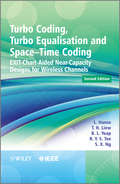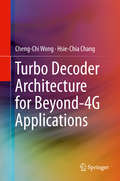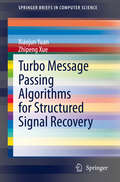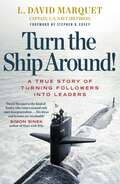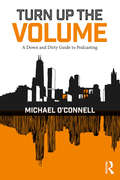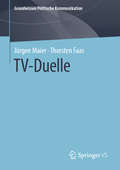- Table View
- List View
Turbo Coding, Turbo Equalisation and Space-Time Coding: EXIT-Chart-Aided Near-Capacity Designs for Wireless Channels (Wiley - IEEE #21)
by Lajos Hanzo T. H. Liew B. L. Yeap R. Y. Tee Soon Xin NgCovering the full range of channel codes from the most conventional through to the most advanced, the second edition of Turbo Coding, Turbo Equalisation and Space-Time Coding is a self-contained reference on channel coding for wireless channels. The book commences with a historical perspective on the topic, which leads to two basic component codes, convolutional and block codes. It then moves on to turbo codes which exploit iterative decoding by using algorithms, such as the Maximum-A-Posteriori (MAP), Log-MAP and Soft Output Viterbi Algorithm (SOVA), comparing their performance. It also compares Trellis Coded Modulation (TCM), Turbo Trellis Coded Modulation (TTCM), Bit-Interleaved Coded Modulation (BICM) and Iterative BICM (BICM-ID) under various channel conditions. The horizon of the content is then extended to incorporate topics which have found their way into diverse standard systems. These include space-time block and trellis codes, as well as other Multiple-Input Multiple-Output (MIMO) schemes and near-instantaneously Adaptive Quadrature Amplitude Modulation (AQAM). The book also elaborates on turbo equalisation by providing a detailed portrayal of recent advances in partial response modulation schemes using diverse channel codes. A radically new aspect for this second edition is the discussion of multi-level coding and sphere-packing schemes, Extrinsic Information Transfer (EXIT) charts, as well as an introduction to the family of Generalized Low Density Parity Check codes. This new edition includes recent advances in near-capacity turbo-transceivers as well as new sections on multi-level coding schemes and of Generalized Low Density Parity Check codes Comparatively studies diverse channel coded and turbo detected systems to give all-inclusive information for researchers, engineers and students Details EXIT-chart based irregular transceiver designs Uses rich performance comparisons as well as diverse near-capacity design examples
Turbo Decoder Architecture for Beyond-4G Applications
by Cheng-Chi Wong Hsie-Chia ChangThis book describes the most recent techniques for turbo decoder implementation, especially for 4G and beyond 4G applications. The authors reveal techniques for the design of high-throughput decoders for future telecommunication systems, enabling designers to reduce hardware cost and shorten processing time. Coverage includes an explanation of VLSI implementation of the turbo decoder, from basic functional units to advanced parallel architecture. The authors discuss both hardware architecture techniques and experimental results, showing the variations in area/throughput/performance with respect to several techniques. This book also illustrates turbo decoders for 3GPP-LTE/LTE-A and IEEE 802.16e/m standards, which provide a low-complexity but high-flexibility circuit structure to support these standards in multiple parallel modes. Moreover, some solutions that can overcome the limitation upon the speedup of parallel architecture by modification to turbo codec are presented here. Compared to the traditional designs, these methods can lead to at most 33% gain in throughput with similar performance and similar cost.
Turbo-like Codes: Design for High Speed Decoding
by Aliazam AbbasfarThis book introduces turbo error correcting concept in a simple language, including a general theory and the algorithms for decoding turbo-like code. It presents a unified framework for the design and analysis of turbo codes and LDPC codes and their decoding algorithms. A major focus is on high speed turbo decoding, which targets applications with data rates of several hundred million bits per second (Mbps).
Turbo Message Passing Algorithms for Structured Signal Recovery (SpringerBriefs in Computer Science)
by Xiaojun Yuan Zhipeng XueThis book takes a comprehensive study on turbo message passing algorithms for structured signal recovery, where the considered structured signals include 1) a sparse vector/matrix (which corresponds to the compressed sensing (CS) problem), 2) a low-rank matrix (which corresponds to the affine rank minimization (ARM) problem), 3) a mixture of a sparse matrix and a low-rank matrix (which corresponds to the robust principal component analysis (RPCA) problem). The book is divided into three parts. First, the authors introduce a turbo message passing algorithm termed denoising-based Turbo-CS (D-Turbo-CS). Second, the authors introduce a turbo message passing (TMP) algorithm for solving the ARM problem. Third, the authors introduce a TMP algorithm for solving the RPCA problem which aims to recover a low-rank matrix and a sparse matrix from their compressed mixture. With this book, we wish to spur new researches on applying message passing to various inference problems. Provides an in depth look into turbo message passing algorithms for structured signal recoveryIncludes efficient iterative algorithmic solutions for inference, optimization, and satisfaction problems through message passingShows applications in areas such as wireless communications and computer vision
Turbulenzen in der Telekommunikations- und Medienindustrie: Neue Geschäfts- und Erlösmodelle
by Thomas Hess Stefan DoeblinTelekommunikations- und Medienmärkte sind in heftiger Bewegung. Digitalisierung, Konvergenz und neue Technologien verändern traditionelle Geschäftsgrundlagen: Zutritt neuer Wettbewerber, neuartige Geschäftsmodelle, neue Formen der strategischen Fokussierung, branchenübergreifende Vernetzung. Der Münchner Kreis präsentierte bei seinem Kongress unter Mitwirkung hochrangiger Referenten Konzepte, Perspektiven der Praxis sowie Forschungsergebnisse.
Turn The Ship Around!: A True Story of Building Leaders by Breaking the Rules
by L. David Marquet'David Marquet is the kind of leader who comes around only once in a generation ... his ideas and lessons are invaluable' Simon Sinek, author of Start With WhyCaptain David Marquet was used to giving orders. In the high-stress environment of the USS Santa Fe, a nuclear-powered submarine, it was crucial his men did their job well. But the ship was dogged by poor morale, poor performance and the worst retention in the fleet. One day, Marquet unknowingly gave an impossible order, and his crew tried to follow it anyway. He realized he was leading in a culture of followers, and they were all in danger unless they fundamentally changed the way they did things. Marquet took matters into his own hands and pushed for leadership at every level. Before long, his crew became fully engaged and the Santa Fe skyrocketed from worst t first in the fleet. No matter your business or position, you can apply Marquet's approach to create a workplace where everyone takes responsibility for their actions, people are healthier and happier - and everyone is a leader.
Turn Up the Volume: A Down and Dirty Guide to Podcasting
by Michael O'ConnellTurn Up the Volume equips journalism students, professionals, and others interested in producing audio content with the know-how necessary to launch a podcast for the first time. It addresses the unique challenges beginner podcasters face in producing professional level audio for online distribution. Beginners can learn how to handle the technical and conceptual challenges of launching, editing, and posting a podcast. This book exposes readers to various techniques and formats available in podcasting. It includes the voices of industry experts as they recount their experiences producing their own podcasts and podcast content. It also examines how data analytics can help grow an audience and provide strategies for marketing and monetization. Written accessibly, Turn Up the Volume gives you a clear and detailed path to launching your first podcast.
Turn Up the Volume: A Down and Dirty Guide to Podcasting
by Michael O'ConnellTurn Up the Volume equips journalism students, professionals, and others interested in producing audio content with the know-how necessary to launch a podcast for the first time. It addresses the unique challenges beginner podcasters face in producing professional level audio for online distribution. Beginners can learn how to handle the technical and conceptual challenges of launching, editing, and posting a podcast. This book exposes readers to various techniques and formats available in podcasting. It includes the voices of industry experts as they recount their experiences producing their own podcasts and podcast content. It also examines how data analytics can help grow an audience and provide strategies for marketing and monetization. Written accessibly, Turn Up the Volume gives you a clear and detailed path to launching your first podcast.
A Tutorial on Queuing and Trunking with Applications to Communications (Synthesis Lectures on Communications)
by William Tranter Allen B. MacKenzieThe motivation for developing this synthesis lecture was to provide a tutorial on queuing and trunking, with extensions to networks of queues, suitable for supplementing courses in communications, stochastic processes, and networking. An essential component of this lecture is MATLAB-based demonstrations and exercises, which can be easily modified to enable the student to observe and evaluate the impact of changing parameters, arrival and departure statistics, queuing disciplines, the number of servers, and other important aspects of the underlying system model. Much of the work in this lecture is based on Poisson statistics, since Poisson models are useful due to the fact that Poisson models are analytically tractable and provide a useful approximation for many applications. We recognize that the validity of Poisson statistics is questionable for a number of networking applications and therefore we briefly discuss self-similar models and the Hurst parameter, long-term dependent models, the Pareto distribution, and other related topics. Appropriate references are given for continued study on these topics. The initial chapters of this book consider individual queues in isolation. The systems studied consist of an arrival process, a single queue with a particular queuing discipline, and one or more servers. While this allows us to study the basic concepts of queuing and trunking, modern data networks consist of many queues that interact in complex ways. While many of these interactions defy analysis, the final chapter introduces a model of a network of queues in which, after being served in one queue, customers may join another queue. The key result for this model is known as Jackson's Theorem. Finally, we state the BCMP Theorem, which can be viewed as a further extension of Jackson's Theorem and present Kleinrock's formula, which can be viewed as the network version of Little's Theorem. Table of Contents: Introduction / Poisson, Erlang, and Pareto Distributions / A Brief Introduction to Queueing Theory / Blocking and Delay / Networks of Queues
Tutorials in Bilingualism: Psycholinguistic Perspectives
by Annette M. B. de Groot Judith F. KrollThe past fifteen years have witnessed an increasing interest in the cognitive study of the bilingual. A major reason why psychologists, psycholinguists, applied linguists, neuropsychologists, and educators have pursued this topic at an accelerating pace presumably is the acknowledgment by increasingly large numbers of language researchers that the incidence of monolingualism in individual language users may be lower than that of bilingualism. This alleged numerical imbalance between monolinguals and bilinguals may be expected to become larger due to increasing international travel through, for instance, tourism and trade, to the growing use of international communication networks, and to the fact that in some parts of the world (i.e., Europe), the borders between countries are effectively disappearing. In addition to the growing awareness that bilinguals are very common and may even outnumber monolinguals, there is the dawning understanding that the bilingual mind is not simply the sum of the cognitive processes associated with each of the two monolingual modes, and that the two languages of bilingual may interact with one another in complicated ways. To gain a genuinely universal account of human cognition will therefore require a detailed understanding of language use by both pure monolinguals as well as bilinguals, unbalanced and balanced, and of the representations and processes involved. These two insights, that bilingualism is a common human condition and that it may influence cognition, were presumably instrumental in putting bilingualism on the agendas of many researchers of cognition and language in recent years. But other reasons may have played a role too: The study of bilingualism also provides a unique opportunity to study the relation between language and thought. A final reason for the growing interest in this area of research is the awareness that bilingualism may confer the benefit of broadening one's scope beyond the limits of one's own country and culture. This book serves as an excellent introduction to the important topics in the psycholinguistic study of bilingualism. The chapters represent a comprehensive and interrelated set of topics that form the core of contemporary research on the psycholinguistics of bilingualism. The issues raised within this perspective not only increase our understanding of the nature of language and thought in bilinguals but also of the basic nature of the mental architecture that supports the ability to use more than one language.
Tutorials in Bilingualism: Psycholinguistic Perspectives
by Judith F. Kroll Annette M. B. De GrootThe past fifteen years have witnessed an increasing interest in the cognitive study of the bilingual. A major reason why psychologists, psycholinguists, applied linguists, neuropsychologists, and educators have pursued this topic at an accelerating pace presumably is the acknowledgment by increasingly large numbers of language researchers that the incidence of monolingualism in individual language users may be lower than that of bilingualism. This alleged numerical imbalance between monolinguals and bilinguals may be expected to become larger due to increasing international travel through, for instance, tourism and trade, to the growing use of international communication networks, and to the fact that in some parts of the world (i.e., Europe), the borders between countries are effectively disappearing. In addition to the growing awareness that bilinguals are very common and may even outnumber monolinguals, there is the dawning understanding that the bilingual mind is not simply the sum of the cognitive processes associated with each of the two monolingual modes, and that the two languages of bilingual may interact with one another in complicated ways. To gain a genuinely universal account of human cognition will therefore require a detailed understanding of language use by both pure monolinguals as well as bilinguals, unbalanced and balanced, and of the representations and processes involved. These two insights, that bilingualism is a common human condition and that it may influence cognition, were presumably instrumental in putting bilingualism on the agendas of many researchers of cognition and language in recent years. But other reasons may have played a role too: The study of bilingualism also provides a unique opportunity to study the relation between language and thought. A final reason for the growing interest in this area of research is the awareness that bilingualism may confer the benefit of broadening one's scope beyond the limits of one's own country and culture. This book serves as an excellent introduction to the important topics in the psycholinguistic study of bilingualism. The chapters represent a comprehensive and interrelated set of topics that form the core of contemporary research on the psycholinguistics of bilingualism. The issues raised within this perspective not only increase our understanding of the nature of language and thought in bilinguals but also of the basic nature of the mental architecture that supports the ability to use more than one language.
The TV Brand Builders: How to Win Audiences and Influence Viewers
by Andy Bryant Charlie MawerThe TV Brand Builders is the definitive account of how the biggest television networks, channels and programmes are created as brands, with rare privileged access to the marketing strategies and creative thinking behind culturally defining TV promos, digital and social media campaigns and design identities. Written by two leading practitioners responsible for work as famous as the BBC One hippos, the creation of a TV channel called Dave and the re-launch of Doctor Who, and featuring interviews with 50 leading industry experts from 8 countries, from HBO to ESPN, from DreamWorks to CANAL+, The TV Brand Builders combines practical advice and strategic insight with exclusive stories from the ratings front line. Online resources include a bonus chapter on TV channel design in a multi-screen world, plus a 'Student and Instructor's Manual' with chapter summaries.
The TV Brand Builders: How to Win Audiences and Influence Viewers
by Andy Bryant Charlie MawerThe TV Brand Builders is the definitive account of how the biggest television networks, channels and programmes are created as brands, with rare privileged access to the marketing strategies and creative thinking behind culturally defining TV promos, digital and social media campaigns and design identities. Written by two leading practitioners responsible for work as famous as the BBC One hippos, the creation of a TV channel called Dave and the re-launch of Doctor Who, and featuring interviews with 50 leading industry experts from 8 countries, from HBO to ESPN, from DreamWorks to CANAL+, The TV Brand Builders combines practical advice and strategic insight with exclusive stories from the ratings front line. Online resources include a bonus chapter on TV channel design in a multi-screen world, plus a 'Student and Instructor's Manual' with chapter summaries.
TV-Duelle (Grundwissen Politische Kommunikation)
by Jürgen Maier Thorsten FaasTV-Duelle sind ein fester Bestandteil und zugleich das wichtigste Einzelereignis in modernen Wahlkämpfen. Sie werden von Millionen von Zuschauerinnen und Zuschauern gesehen und umfassend in Massenmedien, aber zunehmend auch in den neuen Medien begleitet. Das vorliegende Buch gibt einen Überblick über Geschichte, Nutzung, Inhalte und Wirkungen von TV-Duellen. Im Fokus stehen dabei vor allem TV-Duelle in Deutschland. Der InhaltTV-Duelle in modernen Wahlkämpfen • Debattenforschung, aber wie? • Geschichte, Verbreitung und Varianten von TV-Duellen • Debatteninhalte und Debattenstrategien • Nutzung von TV-Duellen: Umfang, Rezipientenmerkmale und -motive • Wahrnehmung von TV-Duellen und Wahrnehmung des Debattensiegers • Wirkung von TV-Duellen • Kommunikation über TV-Duelle • Was gibt es nach 60 Jahren Debattenforschung noch zu untersuchen?Die AutorenProf. Dr. Jürgen Maier ist Professor für Politische Kommunikation an der Universität Koblenz-Landau. Seine aktuellen Arbeitsschwerpunkte liegen in den Bereichen Politische Kommunikation, Wahlen und politische Einstellungen sowie Einsatz experimenteller Designs bei der Untersuchung sozialwissenschaftlicher Fragestellungen.Prof. Dr. Thorsten Faas leitet die Arbeitsstelle "Politische Soziologie der Bundesrepublik Deutschland" am Otto-Suhr-Institut für Politikwissenschaft an der Freien Universität Berlin. Seine Arbeitsschwerpunkte liegen im Bereich von Wahlen, Wahlkämpfen und Wahlstudien.
The TVs of Tomorrow: How RCA’s Flat-Screen Dreams Led to the First LCDs (Synthesis)
by Benjamin GrossIn 1968 a team of scientists and engineers from RCA announced the creation of a new form of electronic display that relied upon an obscure set of materials known as liquid crystals. At a time when televisions utilized bulky cathode ray tubes to produce an image, these researchers demonstrated how liquid crystals could electronically control the passage of light. One day, they predicted, liquid crystal displays would find a home in clocks, calculators—and maybe even a television that could hang on the wall. Half a century later, RCA’s dreams have become a reality, and liquid crystals are the basis of a multibillion-dollar global industry. Yet the company responsible for producing the first LCDs was unable to capitalize upon its invention. In The TVs of Tomorrow, Benjamin Gross explains this contradiction by examining the history of flat-panel display research at RCA from the perspective of the chemists, physicists, electrical engineers, and technicians at the company’s central laboratory in Princeton, New Jersey. Drawing upon laboratory notebooks, internal reports, and interviews with key participants, Gross reconstructs the development of the LCD and situates it alongside other efforts to create a thin, lightweight replacement for the television picture tube. He shows how RCA researchers mobilized their technical expertise to secure support for their projects. He also highlights the challenges associated with the commercialization of liquid crystals at RCA and Optel—the RCA spin-off that ultimately manufactured the first LCD wristwatch. The TVs of Tomorrow is a detailed portrait of American innovation during the Cold War, which confirms that success in the electronics industry hinges upon input from both the laboratory and the boardroom.
The TVs of Tomorrow: How RCA’s Flat-Screen Dreams Led to the First LCDs (Synthesis)
by Benjamin GrossIn 1968 a team of scientists and engineers from RCA announced the creation of a new form of electronic display that relied upon an obscure set of materials known as liquid crystals. At a time when televisions utilized bulky cathode ray tubes to produce an image, these researchers demonstrated how liquid crystals could electronically control the passage of light. One day, they predicted, liquid crystal displays would find a home in clocks, calculators—and maybe even a television that could hang on the wall. Half a century later, RCA’s dreams have become a reality, and liquid crystals are the basis of a multibillion-dollar global industry. Yet the company responsible for producing the first LCDs was unable to capitalize upon its invention. In The TVs of Tomorrow, Benjamin Gross explains this contradiction by examining the history of flat-panel display research at RCA from the perspective of the chemists, physicists, electrical engineers, and technicians at the company’s central laboratory in Princeton, New Jersey. Drawing upon laboratory notebooks, internal reports, and interviews with key participants, Gross reconstructs the development of the LCD and situates it alongside other efforts to create a thin, lightweight replacement for the television picture tube. He shows how RCA researchers mobilized their technical expertise to secure support for their projects. He also highlights the challenges associated with the commercialization of liquid crystals at RCA and Optel—the RCA spin-off that ultimately manufactured the first LCD wristwatch. The TVs of Tomorrow is a detailed portrait of American innovation during the Cold War, which confirms that success in the electronics industry hinges upon input from both the laboratory and the boardroom.
The TVs of Tomorrow: How RCA’s Flat-Screen Dreams Led to the First LCDs (Synthesis)
by Benjamin GrossIn 1968 a team of scientists and engineers from RCA announced the creation of a new form of electronic display that relied upon an obscure set of materials known as liquid crystals. At a time when televisions utilized bulky cathode ray tubes to produce an image, these researchers demonstrated how liquid crystals could electronically control the passage of light. One day, they predicted, liquid crystal displays would find a home in clocks, calculators—and maybe even a television that could hang on the wall. Half a century later, RCA’s dreams have become a reality, and liquid crystals are the basis of a multibillion-dollar global industry. Yet the company responsible for producing the first LCDs was unable to capitalize upon its invention. In The TVs of Tomorrow, Benjamin Gross explains this contradiction by examining the history of flat-panel display research at RCA from the perspective of the chemists, physicists, electrical engineers, and technicians at the company’s central laboratory in Princeton, New Jersey. Drawing upon laboratory notebooks, internal reports, and interviews with key participants, Gross reconstructs the development of the LCD and situates it alongside other efforts to create a thin, lightweight replacement for the television picture tube. He shows how RCA researchers mobilized their technical expertise to secure support for their projects. He also highlights the challenges associated with the commercialization of liquid crystals at RCA and Optel—the RCA spin-off that ultimately manufactured the first LCD wristwatch. The TVs of Tomorrow is a detailed portrait of American innovation during the Cold War, which confirms that success in the electronics industry hinges upon input from both the laboratory and the boardroom.
The TVs of Tomorrow: How RCA’s Flat-Screen Dreams Led to the First LCDs (Synthesis)
by Benjamin GrossIn 1968 a team of scientists and engineers from RCA announced the creation of a new form of electronic display that relied upon an obscure set of materials known as liquid crystals. At a time when televisions utilized bulky cathode ray tubes to produce an image, these researchers demonstrated how liquid crystals could electronically control the passage of light. One day, they predicted, liquid crystal displays would find a home in clocks, calculators—and maybe even a television that could hang on the wall. Half a century later, RCA’s dreams have become a reality, and liquid crystals are the basis of a multibillion-dollar global industry. Yet the company responsible for producing the first LCDs was unable to capitalize upon its invention. In The TVs of Tomorrow, Benjamin Gross explains this contradiction by examining the history of flat-panel display research at RCA from the perspective of the chemists, physicists, electrical engineers, and technicians at the company’s central laboratory in Princeton, New Jersey. Drawing upon laboratory notebooks, internal reports, and interviews with key participants, Gross reconstructs the development of the LCD and situates it alongside other efforts to create a thin, lightweight replacement for the television picture tube. He shows how RCA researchers mobilized their technical expertise to secure support for their projects. He also highlights the challenges associated with the commercialization of liquid crystals at RCA and Optel—the RCA spin-off that ultimately manufactured the first LCD wristwatch. The TVs of Tomorrow is a detailed portrait of American innovation during the Cold War, which confirms that success in the electronics industry hinges upon input from both the laboratory and the boardroom.
Tweeting Brexit: Social Media and the Aftermath of the EU Referendum (Routledge Studies in Media, Communication, and Politics)
by Maja ŠimunjakTweeting Brexit presents the most thorough examination of the role that the most political social network, Twitter, played in creating, negotiating and challenging Brexit narratives during the process of UK’s exiting of the European Union. Working with multiple methods, from digital media analysis to interviews, and a wide variety of data, the book offers scrutiny of Brexit-related tweets and discourses they promote, and gives voice to key actors - UK citizens, political and media actors - to explain why and how they’ve used Twitter to talk about Brexit and with what outcomes. In doing so, the author engages with, and enhances, a range of theoretical discussions central to our understanding of the role of social media in politics, from permanent campaigning on social media to social media journalism. With a reach far beyond the central Brexit case study, the book discusses new trends and practices in political communication and contextualises them with reference to empirical evidence. The book is key reading for all students and researchers in digital media and politics, digital methods and related areas, as well as anyone interested in developing their understanding of the role that Twitter plays in political communications.
Tweeting Brexit: Social Media and the Aftermath of the EU Referendum (Routledge Studies in Media, Communication, and Politics)
by Maja ŠimunjakTweeting Brexit presents the most thorough examination of the role that the most political social network, Twitter, played in creating, negotiating and challenging Brexit narratives during the process of UK’s exiting of the European Union. Working with multiple methods, from digital media analysis to interviews, and a wide variety of data, the book offers scrutiny of Brexit-related tweets and discourses they promote, and gives voice to key actors - UK citizens, political and media actors - to explain why and how they’ve used Twitter to talk about Brexit and with what outcomes. In doing so, the author engages with, and enhances, a range of theoretical discussions central to our understanding of the role of social media in politics, from permanent campaigning on social media to social media journalism. With a reach far beyond the central Brexit case study, the book discusses new trends and practices in political communication and contextualises them with reference to empirical evidence. The book is key reading for all students and researchers in digital media and politics, digital methods and related areas, as well as anyone interested in developing their understanding of the role that Twitter plays in political communications.
Tweeting is Leading: How Senators Communicate and Represent in the Age of Twitter (Oxford Studies in Digital Politics)
by Annelise RussellSocial media is changing the business of representation in the Senate. If you want to know what your senator is up to, you don't need a newspaper, just your phone. Some senators are social media minimalists while others are digitally long-winded, but each senator has the ability to insert themselves into our daily digital routines and frame their political brand for a public audience. Drawing on a unique dataset of almost 200,000 senator tweets, Tweeting is Leading offers a critical analysis of senators' communication on Twitter, the individual and constituent forces that shape it, and the agendas that result. The public priorities that senators communicate through social media--what Annelise Russell calls their rhetorical agenda--offer a necessary tool for understanding how senators link their carefully crafted public image with potential voters. The rhetorical agenda challenges what we know about representation, removing the institutional and political constraints on congressional communication and giving lawmakers a messaging platform where individual discretion is high, the relative costs are low, and someone is always watching. Tweeting is Leading emphasizes why representation on social media matters for understanding media norms and how lawmakers digitally build a political brand, showing empirically how senators self-constrain their communications to curate different styles of representation that match constituent expectations.
Tweeting is Leading: How Senators Communicate and Represent in the Age of Twitter (Oxford Studies in Digital Politics)
by Annelise RussellSocial media is changing the business of representation in the Senate. If you want to know what your senator is up to, you don't need a newspaper, just your phone. Some senators are social media minimalists while others are digitally long-winded, but each senator has the ability to insert themselves into our daily digital routines and frame their political brand for a public audience. Drawing on a unique dataset of almost 200,000 senator tweets, Tweeting is Leading offers a critical analysis of senators' communication on Twitter, the individual and constituent forces that shape it, and the agendas that result. The public priorities that senators communicate through social media--what Annelise Russell calls their rhetorical agenda--offer a necessary tool for understanding how senators link their carefully crafted public image with potential voters. The rhetorical agenda challenges what we know about representation, removing the institutional and political constraints on congressional communication and giving lawmakers a messaging platform where individual discretion is high, the relative costs are low, and someone is always watching. Tweeting is Leading emphasizes why representation on social media matters for understanding media norms and how lawmakers digitally build a political brand, showing empirically how senators self-constrain their communications to curate different styles of representation that match constituent expectations.
The Twentieth Century German Art Exhibition: Answering Degenerate Art in 1930s London (Routledge Research in Art Museums and Exhibitions)
by Lucy WasensteinerThis book represents the first study dedicated to Twentieth Century German Art, the 1938 London exhibition that was the largest international response to the cultural policies of National Socialist Germany and the infamous Munich exhibition Degenerate Art. Provenance research into the catalogued exhibits has enabled a full reconstruction of the show for the first time: its contents and form, its contributors and their motivations, and its impact both in Britain and internationally. Presenting the research via six case-study exhibits, the book sheds new light on the exhibition and reveals it as one of the largest émigré projects of the period, which drew contributions from scores of German émigré collectors, dealers, art critics, and from the ‘degenerate’ artists themselves. The book explores the show’s potency as an anti-Nazi statement, which prompted a direct reaction from Hitler himself.
The Twentieth Century German Art Exhibition: Answering Degenerate Art in 1930s London (Routledge Research in Art Museums and Exhibitions)
by Lucy WasensteinerThis book represents the first study dedicated to Twentieth Century German Art, the 1938 London exhibition that was the largest international response to the cultural policies of National Socialist Germany and the infamous Munich exhibition Degenerate Art. Provenance research into the catalogued exhibits has enabled a full reconstruction of the show for the first time: its contents and form, its contributors and their motivations, and its impact both in Britain and internationally. Presenting the research via six case-study exhibits, the book sheds new light on the exhibition and reveals it as one of the largest émigré projects of the period, which drew contributions from scores of German émigré collectors, dealers, art critics, and from the ‘degenerate’ artists themselves. The book explores the show’s potency as an anti-Nazi statement, which prompted a direct reaction from Hitler himself.
Twentieth-Century Poetic Translation: Literary Cultures in Italian and English
by Daniela Caselli Daniela La PennaTwentieth Century Poetic Translation analyses translations of Italian and English poetry and their roles in shaping national identities by merging historical, cultural and theoretical perspectives. Focusing on specific case studies within the Italian, English and North American literary communities, spanning from 'authoritative' translations of poets by poets to the role of dialect poetry and anthologies of poetry, the book looks at the role of translation in the development of poetic languages and in the construction of poetic canons. It brings together leading scholars in the history of the Italian language, literary historians and translators, specialists in theory of translation and history of publishing to explore the cultural dynamics between poetic traditions in Italian and English in the twentieth century.
